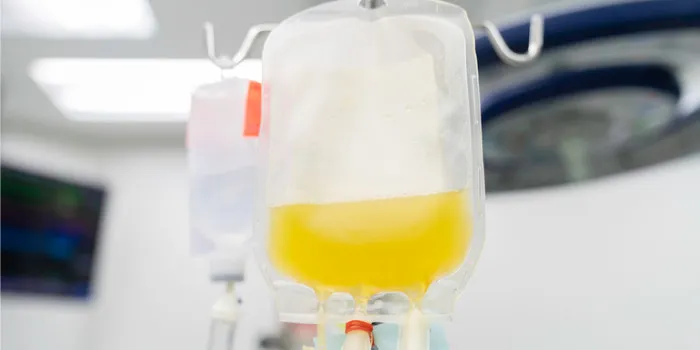When people with hemophilia develop an inhibitor—about 1/3 to 1/5 of people with severe hemophilia A and 1% to 4% of those with severe hemophilia B—treatment becomes more challenging. An inhibitor is an immune system response to infused clotting factor concentrates, which makes standard replacement therapy ineffective.
That said, there still are treatments for those who develop inhibitors; among them, plasmapheresis (pronounced plaz-mə-fə-ˈrē-səs) and therapeutic plasma exchange. Some may think these are identical, but there are key differences between the two similar treatments.
As insurance company Aetna points out, “the terms plasmapheresis (PP) and plasma exchange (PE) are often used interchangeably, but when properly used, denote different procedures.”
What Is Plasmapheresis?
Plasmapheresis is a treatment process that involves separating the liquid part of the blood, or plasma, from the blood cells. The plasma is then usually replaced with another solution such as saline or albumin, or the plasma is treated and then returned to the body. Plasmapheresis is used on autoimmune disorders—such as hemophilia—which renders the body’s natural defense unable to tell the difference between your own cells and foreign cells, causing the body to mistakenly attack normal cells. Plasmapheresis can stop this process by removing the plasma that contains antibodies and replacing it with new plasma.
The first step of the treatment involves drawing whole blood from the patient. Then, the drawn blood is put into a plasmapheresis machine—a centrifuge that spins rapidly to separate the plasma from the blood cells.
“Plasma is naturally lighter than many other components, so it tends to rise to the top during this process,” Healthline states. “The machine will keep the plasma and send other components, such as red blood cells, back into your body.”
Plasmapheresis has been used as an effective treatment for acquired hemophilia A.
“Our case findings suggested that plasma exchange is an effective method for eliminating factor VIII inhibitor and alleviating acquired hemophilia A severity,” one study states. The same study found that the use of plasma exchange for treating acquired hemophilia A is beneficial in several ways, one being that it prevents complications such as infection due to excessive immunosuppression in patients who are elderly.
What Is Therapeutic Plasma Exchange?
Therapeutic plasma exchange is similar, as it also involves removing plasma with harmful antibodies from the bloodstream. However, where plasmapheresis includes manipulating plasma once it’s separated and returning it to the body, therapeutic plasma exchange refers to discarding the plasma completely and substituting a replacement fluid (usually donor plasma or albumin solution).
Therapeutic plasma exchange is used to treat certain blood, neurological and autoimmune diseases such as thrombotic thrombocytopenic purpura, Guillain-Barré syndrome, multiple sclerosis, chronic inflammatory demyelinating polyradiculoneuropathy, Lambert-Eaton syndrome, myasthenia gravis, and some kidney diseases such as Goodpasture syndrome. Reports indicate that therapeutic plasma exchange is a fairly painless procedure and serious side effects are rare.

